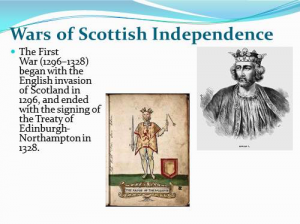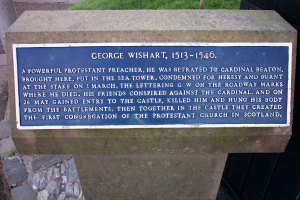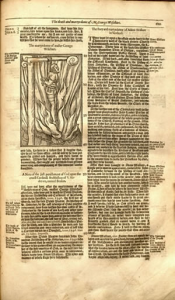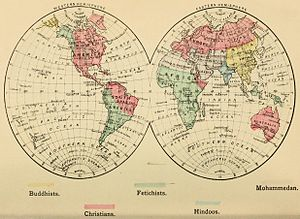March 1st Scots Book of Days
MARCH 1 601 David, Bishop of Menevia, Patron of Wales, feast day. When the King of Scotland, James 6th, took the English throne -1603, James became King of the Welsh.
1328 Parliament at York and Peace Treaty of Edinburgh Northampton. English prepare for peace with Scotland. This is after the failed invasion to the River Wear the previous summer (July 31 to August 7th 1328 as the year 1328 continues to and ends on March 24th)
 Picture Right, Robert 1 (King of Scots) volna.org
Picture Right, Robert 1 (King of Scots) volna.org
The English monarch renounced fully and for ever, all claims of dominion and superiority over Scotland. All charters and documents carried away by Edward the First should be returned to Scotland. Scotland as a Kingdom should be secured to Bruce and heirs, as it had existed in the reign of Alexander the 3rd, with perpetual peace between the 2 kingdoms. Also, a marriage between Princess Joanna (age 7), sister to King Edward 3rd (age 16), called Joan of England, Joan of the Tower, Queen of Scots, as consort to King David 2nd, son of the Bruce King of Scots. Joan was born in the Tower of London. Tytler’s Britannica.
1546 – George Wishart, a Protestant martyr, was burnt at the stake in the presence of Cardinal Beaton, outside St Andrews Castle George Wishart (c.1513-1546 age 33) was a reforming preacher. Wishart was convicted of heresy after being tried by a convocation of bishops and other clergy, including Cardinal David Beaton. Before the execution, the Captain of St Andrews Castle invited Wishart to share his breakfast. Having blessed the bread and wine, Wishart celebrated the first Protestant Communion in Scotland.
 Monument text –George Wishart, 1513-1546. A powerful Protestant preacher, was betrayed to Cardinal Beaton, brought here, Put in the Sea Tower, Condemned for heresy and Burnt at the stake on 1 March. The lettering G W on the Roadway Marks where he died. His Friends conspired against the Cardinal, and on 26 May gained entry to the castle, Killed the Cardinal and hung his body from the battlements, then together in the castle they created the first congregation of the Protestant Church in Scotland.
Monument text –George Wishart, 1513-1546. A powerful Protestant preacher, was betrayed to Cardinal Beaton, brought here, Put in the Sea Tower, Condemned for heresy and Burnt at the stake on 1 March. The lettering G W on the Roadway Marks where he died. His Friends conspired against the Cardinal, and on 26 May gained entry to the castle, Killed the Cardinal and hung his body from the battlements, then together in the castle they created the first congregation of the Protestant Church in Scotland.
Following Wishart’s death, Cardinal Beaton was murdered in St Andrews Castle by John Leslie, brother of the [Andrew Leslie, 5th] Earl of Rothes, his nephew Norman [Leslie] and Kirkcaldy of Grange on 29 May 1546. (Later members of the Lords of the Congregation as of June 1559 included the Earl of Rothes, with John Wishart, Laird of Pitarro and Kirkcaldy as councilors by October 1559). The spot where George Wishart died is marked by the letters GW in cobblestones outside the Castle, and commemorated by a plaque nearby (erected jointly by the St Andrews Preservation Trust and the Wishart Society). He is also recorded on the Martyrs’ Monument at St Andrews.
 The woodcut is taken from John Foxe’s Book of Martyrs (1641 edition).
The woodcut is taken from John Foxe’s Book of Martyrs (1641 edition).
1546 – 1547. The Reformation gathers pace in England and Scotland.
1562 A massacre of Protestants (often called Huguenots) by Catholics near Paris (Toulouse) ignites the first of eight French ‘wars of religion’. BBC. This was two years after the 1560 creation of the Church of Scotland or Presbyterian, pausing 3 centuries of the auld alliance between Scotland and France, with Protestants fleeing France to England and Scotland. By 1561, the French King’s [Francis II] council (ignoring the complaints of Gaspard II de Coligny) dismissed the mercenary Scots guard, guarding the King, because they were almost all Protestants, and under command of James Hamilton, 3rd Earl of Arran, who returned to Scotland. The auld alliance would not be restored until late in the 19th century. How’d that work for you France?
 Expulsion of the Huguenots of Toulouse after the Capture of the Town by the Prince of Conde’s Supporters in 1562 by Antoine Rivalz, 1727. Wikipedia
Expulsion of the Huguenots of Toulouse after the Capture of the Town by the Prince of Conde’s Supporters in 1562 by Antoine Rivalz, 1727. Wikipedia
1599 never happened in Scotland because most of the month was skipped, as the year was to begin on January 1st instead of March 25th (Vernal equinox). Dating its years from the birth of Jesus Christ, so that ‘’ every nation, kindred, every ear shall hear, every knee shall bow, and every tongue shall confess, Jesus Christ is Lord,’’ thru computer software applications and aviation, the Christian calendar has been adopted world wide for the Musselmen of Islam, the Buddhist, Confucian, Hindu, nativist, Jew, agnostic, or atheist(Isaiah 45:23, 1 Kings 19:18, Philippians 2:11, Romans 14:11, confirmed in modern times Mosiah 16:1, 27:31, Doctrine and Covenants 76:110, 88:104.)
 An 1883 map of the world divided into colors representing “Christians, Buddhists, Hindoos, Mohammedans, Fetichists”. In the summer of 1599, James 6th King of Scots declared the year 1600 to begin on January 1st . Thus the previous Valentine’s day was February 14, 1598, and 1598 continued to March 24th 1598. Then March 25th 1599 to the Summer of 1599, on to Christmas 1599 and New Year’s Eve 1599. Then January 1st 1600. Growing up I always wondered why September (Latin for 7th ), October (Latin for 8th ) November (Latin for 9th ) and December (Latin for 10th ) were so named when they were the 9th , 10th , 11th , and 12th months. And so they were from the time of Augustus Caesar until the 16th century, when Venice (as a Republic it had no KING), changed the year. ye wonder how they could run a calendar different from the rest of the world, but Venice had such a strong navy mercantile industry, it could so do. Venetian Republic also ran the University of Padua, the leading Italian university, perhaps in all of Europe. Changing the calendar also stuck a thumb in the eyes of Rome, Paris, London, Copenhagen, etc.
An 1883 map of the world divided into colors representing “Christians, Buddhists, Hindoos, Mohammedans, Fetichists”. In the summer of 1599, James 6th King of Scots declared the year 1600 to begin on January 1st . Thus the previous Valentine’s day was February 14, 1598, and 1598 continued to March 24th 1598. Then March 25th 1599 to the Summer of 1599, on to Christmas 1599 and New Year’s Eve 1599. Then January 1st 1600. Growing up I always wondered why September (Latin for 7th ), October (Latin for 8th ) November (Latin for 9th ) and December (Latin for 10th ) were so named when they were the 9th , 10th , 11th , and 12th months. And so they were from the time of Augustus Caesar until the 16th century, when Venice (as a Republic it had no KING), changed the year. ye wonder how they could run a calendar different from the rest of the world, but Venice had such a strong navy mercantile industry, it could so do. Venetian Republic also ran the University of Padua, the leading Italian university, perhaps in all of Europe. Changing the calendar also stuck a thumb in the eyes of Rome, Paris, London, Copenhagen, etc.
In England, January 1 was celebrated as the New Year festival, but from the (1st ) or 12th century to 1752 the year in England began on March 25 (Lady Day). The Parliamentary records list the execution of Charles I occurring in 1648 (as the year did not end until March 24 in London), although ignorant modern histories erroneously adjust the start of the year to January 1 and record the execution as occurring in 1649 (in Scotland’s calendar).
Most western European countries changed the start of the year to January 1 before they adopted the Gregorian calendar. Scotland changed the start of the Scottish New Year to January 1 in 1600. England, Ireland and the British colonies changed the start of the year to January 1 in 1752. Later in September 1752, the Gregorian calendar was introduced throughout Britain and the British colonies. These two reforms were implemented by the Calendar (New Style) Act 1750.
January 1 became the official start of the year as follows:
1522 The Republic of Venice
1544 Holy Roman Empire (Germany)
1556 Spain, Portugal (and colonies)
1559 Prussia, Sweden
1564 France
1576 Southern Netherlands
1579 Lorraine (later France)
 American military cemetery Lorraine France. 10,489 souls (40% of Scots ancestry). http://blackquillandink.com/?p=15894
American military cemetery Lorraine France. 10,489 souls (40% of Scots ancestry). http://blackquillandink.com/?p=15894
- The French speak French instead of German because of the American Soldier.
1583 United Provinces of the Netherlands (northern)
1600 Scotland begins its numbered year on January 1 instead of March 25.
1700 Russia changes.
1638 species of engagement, or declaration, was drawn up, the principal object of which was, the eradication of Prelacy (i.e. Roman Catholicism) in all its modifications (i.e. Anglican or English Catholicism), and the establishment of presbytery on its purest and most simple basis. This engagement was called the National Covenant, as resembling those covenants which, in the Old Testament, (i.e. Exodus and other books of Moses), God (i.e. Jehovah) was said to have made with the people of Israel The terms of this memorable league professed the Reformed faith, and abjured the rites and doctrines of the Romish Church, with which were classed the newly imposed Liturgy and Canons. This covenant, which (TG41-358) had for its object to annul all of prelatic innovation that James’s 1st (1st of England, 6th of Scotland) policy, and his son’s (Charles 1st ) violence, had been able to introduce into the Presbyterian Church, was sworn to by hundreds, thousands, and hundreds of thousands, of every age and description, vowing, with uplifted hands and weeping eyes, that, with the Divine assistance, they would dedicate life and fortune to maintain the object of their solemn engagement. [TG41-359, Tales of a Grandfather, Chap. 41, p. 359] YYMA 21 – National Covenant ministers, burgesses and commons added their signatures in the churchyard next day Greyfriar’s Kirk, Edinburgh.
 The Signing of the National Covenant. The Victorian painter William Hole places Henderson at the centre of events in 1638.
The Signing of the National Covenant. The Victorian painter William Hole places Henderson at the centre of events in 1638.
The avowed opposition, enforced by the English Penal laws, by the established Government in London to these covenants would lead to the emigration (outward fleeing) of most of the Scottish nation over the next two centuries, most to the Northern Atlantic Station (to wit American colonies). The Penal laws, originally inspired as anti Catholic laws, but conveniently applicable to Presbytery, would in turn inspire the U.S. Constitution Article 6 (no Test acts) and the Bill of Rights (1st Amendment Freedoms of speech, press, assembly, petition, and religion, 2nd Amendment Bear Arms (rifles, guns), 3rd thru 10th Amendments), jury trial, no tortured confessions, public trial, confrontation of witnesses, etc.
Henderson was mainly responsible for the final form of this document, which consisted of the kings confession drawn up in 1581 by John Craig a recital of the acts of parliament against superstitious and papistical rites, an elaborate oath to maintain the true reformed religion. (A pattern used in the United States Declaration of Independence on July 4th 1776.)  Scottish and English Royalty, House of Stuart
Scottish and English Royalty, House of Stuart
1649 – The House of Commons of England passes an act abolishing the House of Lords, declaring it “useless and dangerous to the people of England”. The House of Lords was restored in 1661, then to be (80%) elected as of 2012.
1740 Marquess of Beaufort created 14 March 1740 for Fraser became extinct 8 December 1815, subsidiary title of the Duke of Fraser.
1751 did not occur in England, Ireland, British North America, and British colonies, as 1751 only had 282 days due to the Calendar Act of 1750. But 1751 did occur in Scotland, as 1751 had 365 days. The world’s oldest lunar “calendar” is in an Aberdeenshire field.
1803 Ohio becomes a state. Scottish place names include (Wikipedia)-
Aberdeen, Albany, Alexandria, Anderson, Angus, Arlington, Armadal, Armstrong, Ashton, Avon, Bannock, Barclay, Barnhill, Barrick, Belmont, Bernice, Blacktop, Brighton, Broc, Brookfield, Broughton, Buchanan, Caldwell, Caledonia, Cameron, Campbell, Campbellstown, Carrington, Chapel Hill, Charlestown, Chester(s), Chester Center, Cheviot, Churchill, Clayton, Clifton, Clyde, Coulter, Cove , Covington, Craigton, Crawford, Crossroads, Crown City, Cunningham, Dalton, Dipple, Douglas, Dunbar, Duncanwood, Dundee, East Clayton, East Mansfield, East Monroe, East Springfield, Edinburg, Elgin, Fincastle, Flushing, Fort McKinley, Fulton County,Galloway, Garfield, Georgetown, Gilmore, Glasgow, Glen Roy, Glenbyrne Center, Glencoe, Glendale, Glenmoor, Gordon, Grant, Greenfield, Gretna, Hamilton, Harris, Hartwell, Hatton, Hazelton Corners, Hecla, Hepburn, Highland, Highland County, Highland Park, Highlandtown, Hope, Houston, Hunter, Jamestown, Keith, Kerr, Kingston, Kirkwood, Knollwood Village, Leith, Linwood, Lock Port, Lockwood Corners, Logan, Lower Newport, Lynn, Lyons, Mansfield, Maud, Mayfield, McArthur, McClure, McComb, McConnelsville, McCracken Corners, McCuneville, McCutchenville, McDaniel Crossroad, McDermott, McDonald, McFarlands Corners, McGaw, McGill, McGuffey, McIntyre, McKay, McKays Corners, McKendree , McLeish, McMorran, Melrose, Middleton, Middleton Corner, Millport, Milton Center, Monroe, Montrose, Mount Hope, Mount Saint John, Mount Sterling, Mount Vernon, Munroe Falls, Murray City, New Albany, New Alexandria, New Hope, New Middleton, New Springfield, Newark, Newburgh Heights, Newkirk, Newport, Newton Falls, North Greenfield, Northfield, Oakley, Oakwood, Overlook Hills, Peebles, Port William, Red Lion, Ross, Ross County, Ross Township (four places), Rossburg, Saint Johns, Saint Martin, Saint Marys, Scotch Ridge, Scotland, Scott, Scott Corners, Scotts Crossing, Scott Township (four places), Scottown, South Charleston, South Hill Park, South Mount Vernon, Springfield, Stanhope, Stanley, Starr, Sterling, Stewart, Struthers, Thompson, Upland Heights, Waverly, Weems, West Alexandria, West Charleston, West Chester, West Covington, West Hill, West Mansfield, West Milton, West Newton, Westfield, Westhill Heights, Westhope, Weston, Westwood, Whitehall, Whitehouse, Wick, Winfield, Woodlawn, Woodside.
 Seal of the Territory of the U. S. NW of the River Ohio, Motto, Meliorem Lapsa Locavit. 1792-1802
Seal of the Territory of the U. S. NW of the River Ohio, Motto, Meliorem Lapsa Locavit. 1792-1802
1831 House of Commons. Parliamentary reform. Franchise realigned. Non resident voters deprived of voting. Tytler’s Britannica.
1836 siege at The Alamo Mission San Antonio, Texas Republic (February 23 – March 6, 1836) ends at the Battle of the Alamo on March 6 with list of Scots defenders. Restored in 1847 by Colonel James Harvey Ralston.
1867 Nebraska becomes a state. Scottish place names include (Wikipedia)-
Adams Albion, Alexandria, Angus, Arlington, Ashton, Ayr, Baxter, Beechwood, Belmont, Blaine, Blair, Bloomfield, Cameron, Campbell, Chester, Clyde, Elgin, Fordyce,
 The Great Seal of the State of Nebraska March 1, 1867, Equality Before the Law
The Great Seal of the State of Nebraska March 1, 1867, Equality Before the Law
1880 Scrooge McDuck (fictional Clan McDuck) emigrates to the United States. He first meets his uncle, Mississippi river boater Angus “Pothole” McDuck, and the Beagle Boys, a family of outlaws that remain his enemies for the rest of his immortal life.
1889 Oliver, Vere Langford leaves Antigua to write, in 3 volumes, The history of the island of Antigua, one of the Leeward Caribbean in the West Indies, from the first settlement in 1635 to the present time [1894-1899], wherein she lists Andrew Millar VI’s doctor brother, whose name is given in the Fasti as Robert appears actually to have been William: numerous documents referring to him are reproduced in Vol. II of Vere L. Oliver’s History of Antigua. During the mid-18th century (i.e. 1740s-1750s), William Millar. Physician of Antigua served the island for many years as physician and surgeon, interspersing his residence with occasional trips to London. Perhaps because of his profession, he was witness to or executor of a remarkable number of wills, within [69 YYMA] and outside the family. Transcripts given include the testaments of two of his brothers, Captain Archibald Miller of the Royal Navy, and Andrew Millar Vi, the London bookseller. The detailed provisions of these documents, specifying remembrances as well as money, suggest that this generation of the family was especially close knit.
1896 French scientist Henri Becquerel accidentally discovers radiation, for which he receives a Nobel prize.
1910 James David Graham Niven (1 March 1910 – 29 July 1983), ‘David Niven’ Awarded the 1958 Academy Award for Best Actor in Separate Tables. Studied at Royal Military College at Sandhurst. He was gazetted a Lieutenant in the Highland Light Infantry. Niven often claimed that he was born in Kirriemuir, in the Scottish county of Angus in 1909. William Niven, David’s father, was of Scottish descent; his paternal grandfather, David Graham Niven, (1811–1884) was from St. Martins, a village in Perthshire. Kirriemuir, sometimes called Kirrie, is a burgh in Angus, Scotland. (clan Graham)
 David Niven as Geoffrey Crisp. In The First of the Few a 1942 British black-and-white biographical film by Leslie Howard, who stars as R. J. Mitchell, the designer of the Supermarine Spitfire fighter aircraft. Crisp is the portrayal of the Royal Air Force officers and test pilots, who flew Mitchell’s seaplanes and Spitfire. The film’s title alludes to Winston Churchill’s (clan Montgomery) speech describing Battle of Britain aircrew, subsequently known as ‘the Few’: “Never was so much owed by so many to so few”. Wikipedia. Each Spitfire carried eight (8) John Moses Browning Machine Guns, also adapted to the American B-25, which guns were credited with defeating the Nazis (25,294 aerial kills), Japanese aircraft (412) and Japanese shipping (600). AmericanRifle
David Niven as Geoffrey Crisp. In The First of the Few a 1942 British black-and-white biographical film by Leslie Howard, who stars as R. J. Mitchell, the designer of the Supermarine Spitfire fighter aircraft. Crisp is the portrayal of the Royal Air Force officers and test pilots, who flew Mitchell’s seaplanes and Spitfire. The film’s title alludes to Winston Churchill’s (clan Montgomery) speech describing Battle of Britain aircrew, subsequently known as ‘the Few’: “Never was so much owed by so many to so few”. Wikipedia. Each Spitfire carried eight (8) John Moses Browning Machine Guns, also adapted to the American B-25, which guns were credited with defeating the Nazis (25,294 aerial kills), Japanese aircraft (412) and Japanese shipping (600). AmericanRifle
1935 Varessa Her love Story. Movie released. Helen Hayes is Vanessa, living in the Cumberland, England on the Scottish border in Victorian England. Drama. French ending. Still it has the Scottish pipers, and Scots guards. Robert Montgomery loves Vanessa, but unrequited love, Boy meets girl, boy loses girl, boy loses arm. That is the plot.
 Helen Hayes Robert Montgomery, Vanessa Her Love Story.
Helen Hayes Robert Montgomery, Vanessa Her Love Story.
1970 Steven Lee Choate born. (Fraser, Stewart, Leslie clans)
1979 Referendums in Scotland and Wales both reject devolution, crippling Britain’s minority Labour government.
2012 Humor back in the day of barns. MacDonald was repairing shingles high on the roof of his barn, when a gust of wind blew him off balance, and he started sliding off the roof, he prayed with a loud shout, ‘elp me, O Lorrrrrd, I’m fallin’ off the rrrrroof,’ when a loud RrrrIPPP stopped him in mid air, hanging by his pants on a nail at the edge of the roof. MacDonald, relieved, excited, and gasping for air, remembered his prayer and said, ‘Ne’errrrr mind Lorrrrrd, AH just caught me pants on a nail.’
Old Southern humor.
Utah Standard News depends on the support of readers like you.
Good Journalism requires time, expertise, passion and money. We know you appreciate the coverage here. Please help us to continue as an alternative news website by becoming a subscriber or making a donation. To learn more about our subscription options or make a donation, click here.
To Advertise on UtahStandardNews.com, please contact us at: ed@utahstandardnews.com.



Comments - No Responses to “March 1st Scots Book of Days”
Sure is empty down here...